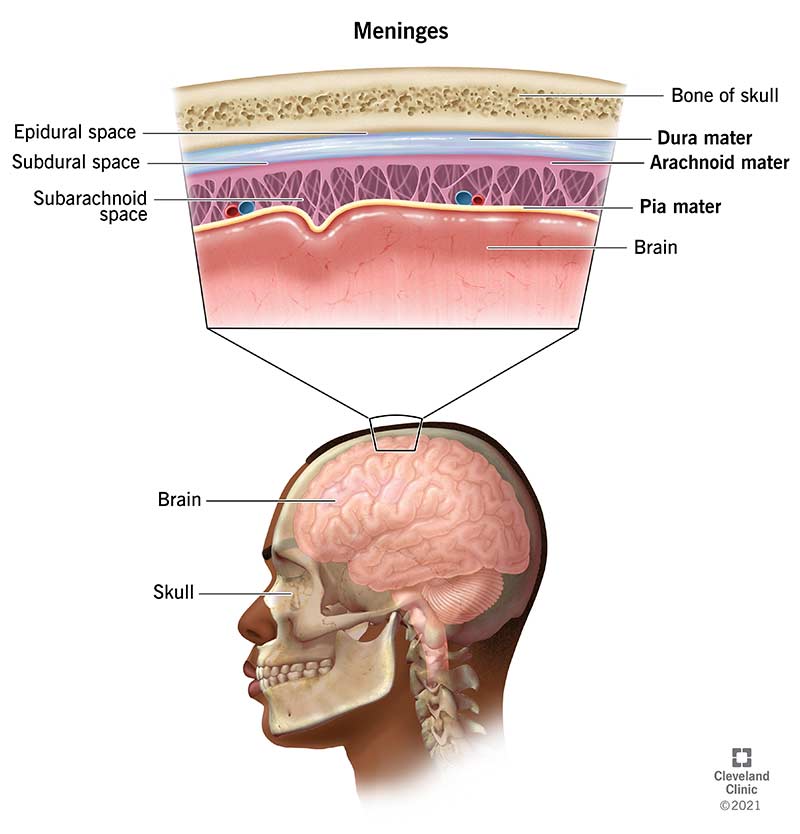Meninges are three membranes layers that cover and protect your brain and spinal cord (central nervous system). These membranes — the dura mater, arachnoid mater and pia mater — protect and anchor your brain and provide a support system for blood vessels, nerves, lymphatics and the cerebrospinal fluid that surrounds your central nervous system.
Advertisement
Cleveland Clinic is a non-profit academic medical center. Advertising on our site helps support our mission. We do not endorse non-Cleveland Clinic products or services. Policy

Meninges are three layers of membranes that cover and protect your brain and spinal cord (your central nervous system [CNS]). They’re known as:
Advertisement
Cleveland Clinic is a non-profit academic medical center. Advertising on our site helps support our mission. We do not endorse non-Cleveland Clinic products or services. Policy
Together, the arachnoid mater and pia mater are called leptomeninges.
There are three spaces within the meninges:
The meninges:
Advertisement
Your dura mater is the outer, thick, strong membrane layer located directly under your skull and vertebral column. In Latin, dura mater means “hard mother.” It consists of two layers of connective tissue. One side of your dura attaches to your skull and the other adheres to your middle membrane layer (arachnoid mater). Your dura mater contains a drainage system, called the dural venous sinuses, which allows blood to leave your brain and allows cerebrospinal fluid to re-enter the circulation. Your dura mater receives its blood supply from your middle meningeal artery and vein, and your trigeminal nerve runs through it.
Your dura mater folds inward onto itself to form four thin membrane layers called dural reflections. Each dural reflection surrounds different sections (hemispheres) of your brain.
Your arachnoid mater, the middle layer of your meninges, lies directly below your dura mater. It’s a thin layer that lays between your dura mater and pia mater. It doesn’t contain blood vessels or nerves. It has a spiderweb-like appearance (“arachnoid” means spider) because it has connective tissue projections that attach to your pia mater. Between your arachnoid mater and pia mater is the subarachnoid space, which contains cerebrospinal fluid that helps cushion your brain.
Your pia mater, the innermost layer, is a thin layer that’s held tightly — like shrink wrap — to the surface of your brain and spinal cord. Many blood vessels pass through this layer to supply your brain tissue with blood. It also helps contain cerebrospinal fluid. In your spinal cord, pia mater helps maintain the stiffness of the cord.
Two of the more common conditions that affect your meninges are:
Other medical conditions affecting your meninges include:
Advertisement
There are many other conditions that can affect each specific meningeal layer. Because of the important role of your meninges in protecting your brain, conditions that affect your meninges can be potentially life-threatening.
Your brain and spinal cord are protected and supported by three meningeal layers. These membrane layers are the dura mater, arachnoid mater and pia mater. The layers plus cerebrospinal fluid keep your brain tissue from jostling against your skull, as well as other functions. Trauma to your head, however, can cause bleeding within any of your meninges and/or your brain tissue itself (intracranial hemorrhage). Be sure to see your healthcare professional if you experience a blow to your head from a trauma (like a car accident), sports injury or fall.
Advertisement
If you have a neurological condition, you want expert advice. At Cleveland Clinic, we’ll work to create a treatment plan that’s right for you.

Last reviewed on 01/11/2022.
Learn more about the Health Library and our editorial process.